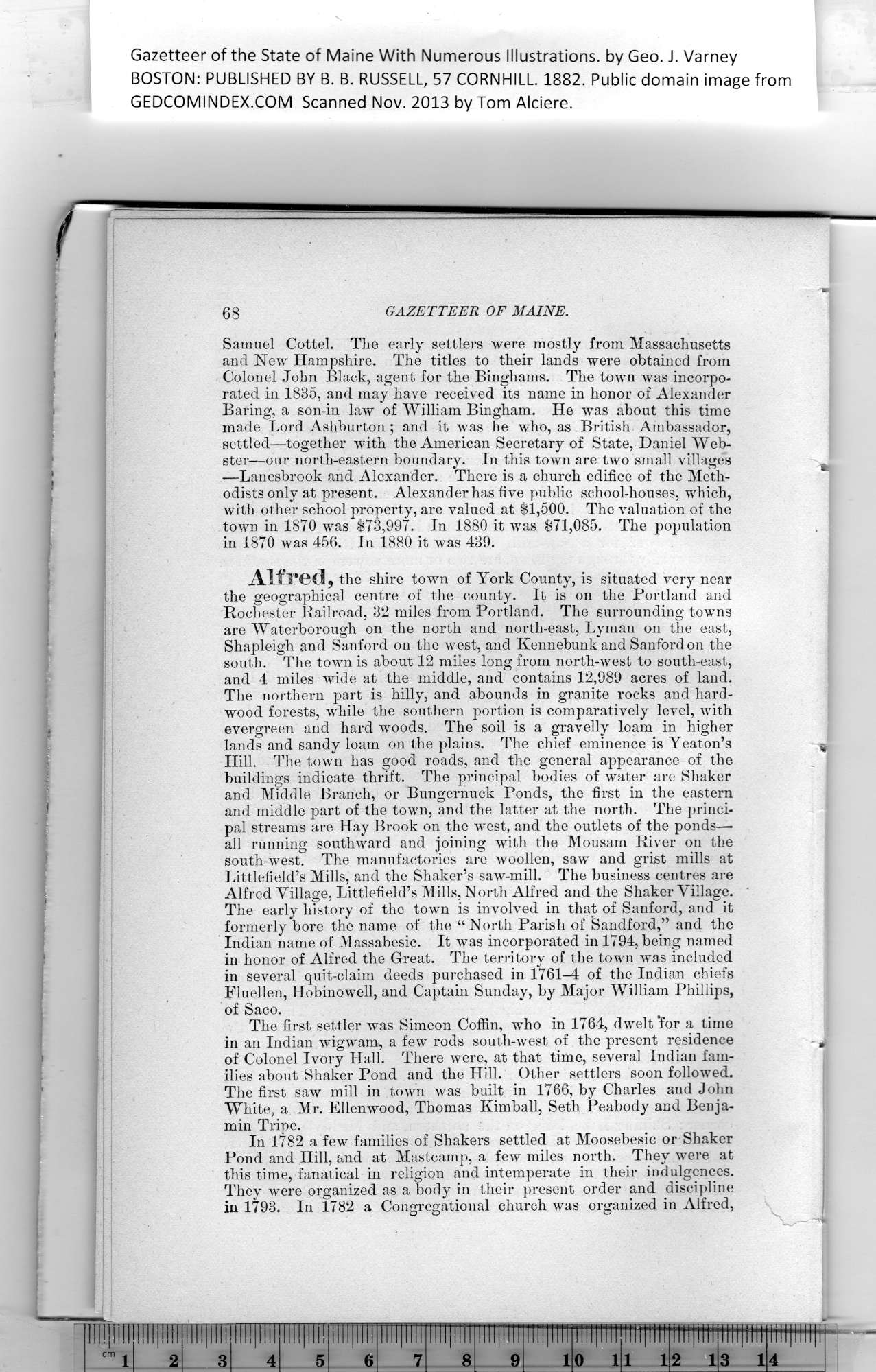|
Gazetteer of the State of Maine With Numerous Illustrations, by Geo. J. Varney
BOSTON: PUBLISHED BY B. B. RUSSELL, 57 CORNHILL. 1882. Public domain image from
68 GAZETTEER OF MAINE.
Samuel Cottel. The early settlers were mostly from Massachusetts
and New Hampshire. The titles to their lands were obtained from
Colonel John Black, agent for the Binghams. The town was incorpo-
rated in 1835, and may have received its name in honor of Alexander
Baring, a son-in law of William Bingham. He was about this time
made Lord Ashburton; and it was he who, as British Ambassador,
settled—together with the American Secretary of State, Daniel Web-
ster—our north-eastern boundary. In this town are two small villages
—Lanesbrook and Alexander. There is a church edifice of the Meth-
odists only at present. Alexander has five public school-houses, which,
with other school property, are valued at $1,500. The valuation of the
town in 1870 was $73,997. In 1880 it was $71,085. The population
in 1870 was 456. In 1880 it was 439.
AlfrOtl, the shire town of York County, is situated very near
the geographical centre of the county. It is on the Portland and
Rochester Railroad, 32 miles from Portland. The surrounding towns
are Waterborough on the north and north-east, Lyman on the east,
Shapleigh and Sanford on the tvest, and Kennebunk and Sanford on the
south. The town is about 12 miles long from north-west to south-east,
and 4 miles wide at the middle, and contains 12,989 acres of land.
The northern part is hilly, and abounds in granite rocks and hard-
wood forests, while the southern portion is comparatively level, with
evergreen and hard woods. The soil is a gravelly loam in higher
lands and sandy loam on the plains. The chief eminence is Yeaton’s
Hill. The town has good roads, and the general appearance of the
buildings indicate thrift. The principal bodies of water are Shaker
and Middle Branch, or Bungernuck Ponds, the first in the eastern
and middle part of the town, and the latter at the north. The princi-
pal streams are Hay Brook on the west, and the outlets of the ponds—
all running southward and joining with the Mousam River on the
south-west. The manufactories are woollen, saw and grist mills at
Littlefield’s Mills, and the Shaker’s saw-mill. The business centres are
Alfred Village, Littlefield’s Mills, North Alfred and the Shaker Village.
The early history of the town is involved in that of Sanford, and it
formerly bore the name of the “North Parish of Sandford,” and the
Indian name of Massabesic. It was incorporated in 1794, being named
in honor of Alfred the Great. The territory of the town wTas included
in several quit-claim deeds purchased in 1761-4 of the Indian chiefs
Fluellen, Hobinowell, and Captain Sunday, by Major William Phillips,
of Saco.
The first settler was Simeon Coffin, who in 1764, dwelt for a time
in an Indian wigwam, a few rods south-west of the present residence
of Colonel Ivory Hall. There were, at that time, several Indian fam-
ilies about Shaker Pond and the Hill. Other settlers soon followed.
The first saw mill in town was built in 1766, by Charles and John
White, a Mr. Ellenwood, Thomas Kimball, Seth Peabody and Benja-
min Tripe.
In 1782 a few families of Shakers settled at Moosebesic or Shaker
Pond and Hill, and at Mastcamp, a few miles north. They were at
this time, fanatical in religion and intemperate in their indulgences.
They were organized as a body in their present order and discipline
in 1793. In 1782 a Congregational church was organized in Alfred,
PREVIOUS PAGE ... NEXT PAGE
This page was written in HTML using a program written in Python 3.2
|
